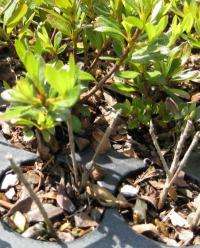Thermotherapy rids azaleas of deadly fungal disease

Azalea web blight, caused by a species of the plant pathogen Rhizoctonia, occurs each year on some containerized azalea cultivars during nursery production, particularly in the southern and eastern United States. Azalea shoots can harbor the pathogen, spreading the devastating, costly disease through propagation.
Research has indicated that simply submerging terminal leafy cuttings of 'Gumpo White' azalea in 50°C water for 21 minutes eliminates binucleate Rhizoctonia species from plant tissues. Before recommending commercial use of the practice—known as "hot water treatment" or "thermotherapy"—industry professionals needed to learn more about potential damage to evergreen azaleas resulting from the treatments. Warren E. Copes of the USDA-Agricultural Research Service (Thad Cochran Southern Horticultural Laboratory) and Eugene K. Blythe of the Coastal Research and Extension Center at Mississippi State University designed experiments to test 12 azalea cultivars for rooting response and sensitivity to a variety of hot water treatments.
Copes and Blythe used terminal cuttings of the azalea cultivars Conleb (Autumn Embers), Fashion, Formosa, Gumpo White, Hardy Gardenia, Hershey Red, Macrantha Pink, Midnight Flare, Red Ruffles, Renee Michelle, Roblel (Autumn Debutante), and Watchet. The cuttings from all 12 cultivars were collected and submerged or not submerged in 50°C water for 20 minutes before propagation in one experiment; all cultivars tolerated the submersion test. Cuttings collected from the 12 cultivars were submerged in 50°C water for 20, 40, 60, and 80 minutes in a second experiment. "The cultivars varied in sensitivity when exposed to 50°C water for 60 to 80 minutes, resulting in differing responses in root development and final leaf count", Copes said.
In a third experiment degrees of leaf damage caused by hot water submersion or by leaf removal were evaluated for the effect on root development and subsequent leaf count on rooted cuttings of 'Gumpo White' and 'Roblel'. According to the results, incremental increases in leaf damage from hot water resulted in incremental reductions in the final leaf count and extent of root development for the two cultivars, while increasing leaf removal caused no reduction until 75% or greater leaf area was removed. "Despite the risks imposed by submersing azalea cuttings, we found all 12 cultivars to be tolerant of submersion durations long enough to eliminate binucleate Rhizoctonia species from stem and leaf tissue with only a low likelihood of sustaining detrimental damage", the scientists wrote in the report published in HortScience.
Copes and Blythe concluded that hot water treatment provides an alternative and effective disease control method for eliminating Rhizoctonia from azalea cuttings. "Thermotherapy provides an example of how simple techniques may provide effective disease control when appropriately applied."
More information: The complete study and abstract are available on the ASHS HortScience electronic journal web site: hortsci.ashspublications.org/c … ent/abstract/46/1/52
Provided by American Society for Horticultural Science


















